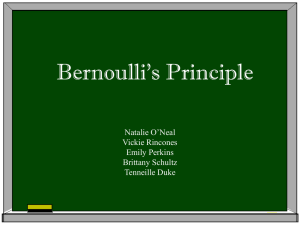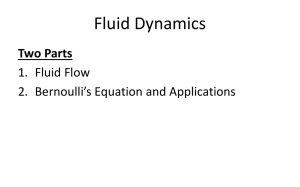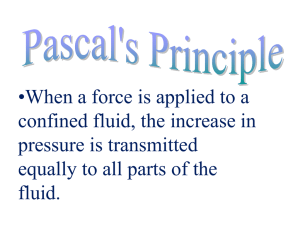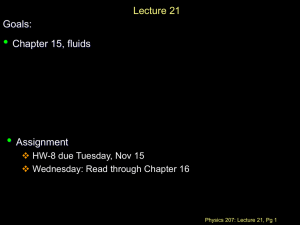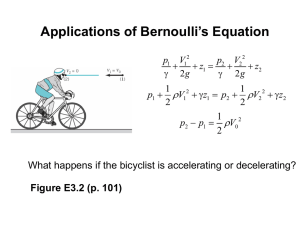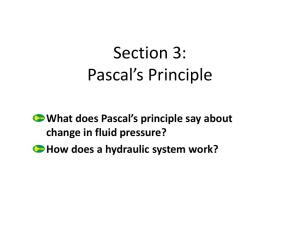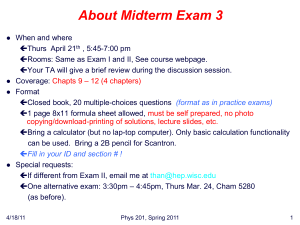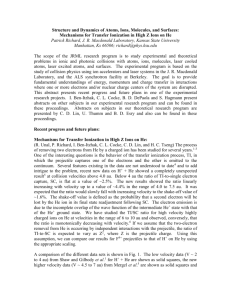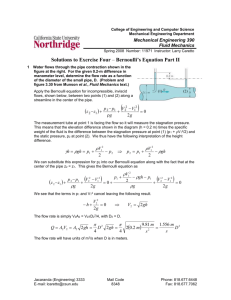Lect26
advertisement
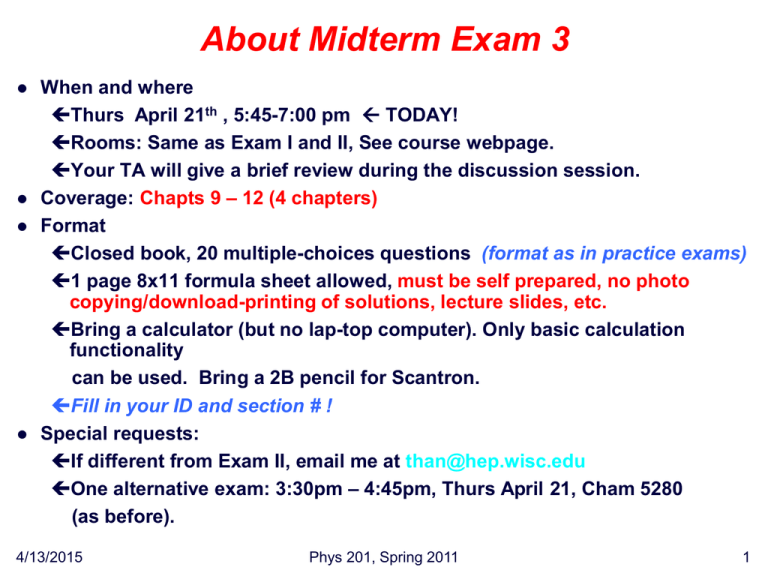
About Midterm Exam 3 When and where Thurs April 21th , 5:45-7:00 pm TODAY! Rooms: Same as Exam I and II, See course webpage. Your TA will give a brief review during the discussion session. Coverage: Chapts 9 – 12 (4 chapters) Format Closed book, 20 multiple-choices questions (format as in practice exams) 1 page 8x11 formula sheet allowed, must be self prepared, no photo copying/download-printing of solutions, lecture slides, etc. Bring a calculator (but no lap-top computer). Only basic calculation functionality can be used. Bring a 2B pencil for Scantron. Fill in your ID and section # ! Special requests: If different from Exam II, email me at than@hep.wisc.edu One alternative exam: 3:30pm – 4:45pm, Thurs April 21, Cham 5280 (as before). 4/13/2015 Phys 201, Spring 2011 1 Physics 201: Lecture 25 Fluids (cont’d) 4/13/2015 Today’s lecture will cover Pascal’s Principle, Archimedes’ Principle revisit Fluids in motion: Continuity & Bernoulli’s equation Phys 201, Spring 2011 2 Archimede’s and Pascal’s Principles A change in pressure F1 applied to an enclosed fluid is transmitted undiminished to all portions of the fluid and to the walls of its container. A A This principle is used in hydraulic system 11 P1 = P2 (F1 / A1) = (F2 / A2) Archimede’s Principle: Buoyant Force weight of fluid displaced » B = ρfluid g Vdisplaced, W = ρobject g Vobject » object sinks if ρobject > ρfluid » object floats if ρobject < ρfluid If object stays floating: B=W » Therefore ρfluid g Vdisplaced = ρobject g Vobject » Therefore Vdisplaced/Vobject = ρobject / ρfluid 4/13/2015 Phys 201, Spring 2011 F2 A 2 3 Fluid Flow Fluid flow without friction • Volume flow rate: ΔV/Δt = A Δd/Δt = Av (m3/s) • No source, no sink Continuity: A1 v1 = A2 v2 = Flow rate i.e., flow rate the same everywhere e.g., flow of river: more slowly in wider area Water through a narrow hose moves faster 4/13/2015 Phys 201, Spring 2011 6 Faucet A stream of water gets narrower as it falls from a faucet (try it & see). Explanation: the equation of continuity A1 V1 V2 A2 The velocity of the liquid increases as the water falls due to gravity. If the volume flow rate is conserved, them the cross-sectional area must decrease in order to compensate The density of the water is the same no matter where it is in space and time, so as it falls down and accelerates because of gravity,the water is in a sense stretched, so it thins out at the end. 4/13/2015 Phys 201, Spring 2011 7 An artery with cross sectional area of 1 cm2 branches into 20 smaller arteries each with 0.5 cm2 cross sectional area. If the velocity of blood in thicker artery is v, what is the velocity of the blood in the thinner arteries? 1. 2. 3. 4. 5. 0.1 v 0.2 v 0.5 v v 2 v F1 =F2 v1A1 =v2 A 2 A1 =1 cm 2 A 2 =20 0.5 cm 2 =10 cm 2 A1 v2 =v1 =0.1v A2 4/13/2015 Phys 201, Spring 2011 8 Bernoulli’s Equation Bernoulli’s Equation 4/13/2015 Phys 201, Spring 2011 9 Bernoulli’s Equation Pressure drops in a rapidly moving fluid whether or not the fluid is confined to a tube For incompressible, frictionless fluid: 1 2 P v gh constant 2 1 2 1 2 1 KE v m v 2 2 V V m gh PE gh V V W Fx PAx PV W E KE PE Bernoulli equation states conservation of energy 4/13/2015 Phys 201, Spring 2011 10 Applications of Bernoulli’s Principle Wings and sails Higher velocity on one side of sail or wing versus the other results in a pressure difference that can even allow the boat to sail into the wind (a) Calculate the approximate force on a square meter of sail, given the horizontal velocity of the wind is 6 m/s parallel to its front surface and 3.5 m/s along its back surface. Take the density of air to be 1.29 kg/m3. (b) Discuss whether this force is great enough to be effective for propelling a sail boat. 1 (v22 v12 )A 15.3 N 2 The force is small. However, when the sails are large, the force can be high enough to propel a sail boat. For larger boats, one can add more than one sail to Force, F (P1 P2 )A increase the surface area. One can even sail into the wind, where (P1 P2 ) is small. 4/13/2015 Phys 201, Spring 2011 11 Pressure drop (a) What is the pressure drop due to Bernoulli effect as water goes into a 3 cm diameter nozzle from a 9 cm diameter fire hose while carrying a flow of 40 L/s? (b) To what maximum height above the nozzle can this water rise neglecting air resistance. F1 40 103 m3 /s v1 6.29 m/s 2 A1 (0.045) F2 40 103 m3 /s v2 56.6 m/s A2 (0.015) 2 1 P1 P2 (v 22 v12 ) 1.58 106 N/m2 2 v 2 (56.6) 2 h m = 163 m 2g 2 9.8 4/13/2015 Phys 201, Spring 2011 12 Velocity Measurement: Pitot tube Two openings at 1 and 2: Dead spot, v1 = 0 1 2 P1 = P2 + v2 , but, P1 - P2 h 2 1 2 h v2 , or wind velocity, v2 h 2 4/13/2015 Phys 201, Spring 2011 13 Torricelli’s Theorem P1, v1, h1 h P2=P1 , v2 , h2 Bernoulli's equation at constant pressure (P1 P2 ) 1 1 P1 v12 gh1 P2 v22 gh 2 2 2 1 2 1 2 v1 gh1 v2 gh 2 2 2 v22 v12 2g(h1 h 2 ) Same as kinematics equation for any object falling h h1 h 2 with negligible friction. 4/13/2015 Phys 201, Spring 2011 14
